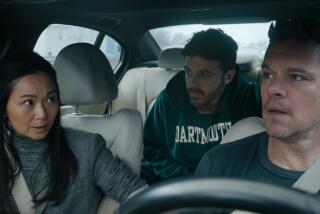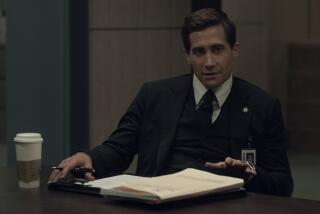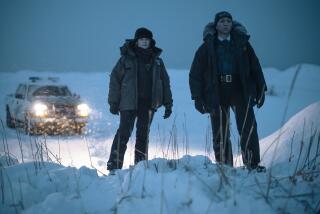MOVIE REVIEW : Going Along for a Wild Ride With ‘The Usual Suspects’
“The Usual Suspects” is a maze moviegoers will be happy to get lost in, a criminal roller coaster with twists so unsettling no choice exists but to hold on and go along for the ride. A fatalistic tale of power, betrayal, crime and punishment, spiced with just a whiff of romance, it is more than anything a polished exercise in pure virtuoso style.
The key stylist is director Bryan Singer, whose debut film, “Public Access,” won the Grand Jury Prize at Sundance a few years back. “Suspects,” with its fine control of the medium, shows Singer to be an uncommon kind of natural filmmaker, disciplined rather than self-indulgent. Cinema is a game he enjoys, and as well as he plays it, he doesn’t do it alone.
Helping him bridge the gap to bigger-budget films, Singer has brought most of his “Public Access” creative team with him, including co-producer Kenneth Kokin, editor-composer John Ottman and, most importantly, screenwriter Christopher McQuarrie, a friend since high school, whose plot sense and vigorous, profane dialogue jolt the film like a high-tension wire.
Singer also knows how to take advantage of the better class of actors now available. With nearly a dozen briskly performed key roles, and all but one of them male, “Suspects” is an accomplished ensemble piece, its characters, each with a distinctive line of mesmerizing chat, oozing macho attitude and hard-guy camaraderie.
The designated storyteller here, in a series of voice-over flashbacks that takes up most of the film, is Roger “Verbal” Kint (Kevin Spacey), a palsied con artist with a twisted foot and a weakness for talking too much.
Verbal is one of two survivors of an explosion in San Pedro harbor that opens the movie, a shipboard blast in which 27 men died over a reported $91 million in cocaine. But relentless U.S. Customs special agent David Kujan (Chazz Palminteri) thinks Verbal knows more than he admits, and his interrogation of the witness is the frame on which the plot unfolds.
Six months before the blast, Verbal relates, five hardened career criminals, himself included, were arrested after a truckload of gun parts was hijacked in Queens, “brought in on trumped-up charges to be leaned on by half-wits.” The other four were the surly Todd Hockney (Kevin Pollak), cocky Michael McManus (Stephen Baldwin) and his partner Fred Fenster (Benicio Del Toro), and, most interesting of all, Dean Keaton (Gabriel Byrne).
An ex-cop who became a crook and who is now, with the help of criminal lawyer girlfriend Edie Finneran (Suzy Amis), trying to go straight again, Keaton is simultaneously admired by the others for his dark skills and taunted for abandoning them. But, as Verbal predicts, “you don’t put guys like that in a room together, you never know what can happen.” What goes down in this case is a plan for that classic one last job, which, of course, turns out to be anything but.
“Suspects’ ” other major strand deals with the second survivor of the explosion, an aged Hungarian gangster. Barely alive, he tells his interrogator that “he saw the devil and looked him in the eye.” He saw, he tells the incredulous and astonished police, Keyser Soze.
Who is Keyser Soze? Only the greatest international criminal mastermind since Dr. Fu Manchu, and, a few people think, just as fictional. Is he, as someone says, “a spook story criminals tell their kids at night,” or is his existence real, his nominally mythical status underlining the truism that “the greatest trick the devil ever pulled was convincing the world that he didn’t exist.” And Kobayashi (British actor Pete Postlethwaite), the hypnotic, unflappable attorney who mysteriously appears to speak for him, certainly is impressive enough. Soon everyone is wondering what is real, what is imaginary, and what exactly is going on?
Detailed as all this may sound, it is only a gloss on “The Usual Suspects’ ” narrative complexity. With cinematographer Newton Thomas Sigel’s fluid camera-work leading the way, Singer and company employ several layers of flashbacks and an intricate way of breaking up scenes that makes them seem even more elusive. Don’t expect to completely follow the plot after the first viewing, or maybe even after the second. But like a tale from the “Arabian Nights,” told for the sheer pleasure of storytelling, this elegant puzzle not only enjoys showing off, it also has something to show.
* MPAA rating: R, violence and a substantial amount of strong language. Times guidelines: the violence, mainly shootouts, come in brief but intense bursts.
(BEGIN TEXT OF INFOBOX / INFOGRAPHIC)
‘The Usual Suspects’
Stephen Baldwin: McManus
Gabriel Byrne: Keaton
Chazz Palminteri: Dave Kujan
Kevin Pollak: Hockney
Pete Postlethwaite: Kobayashi
Kevin Spacey: Verbal
Suzy Amis: Edie Finneran
Benicio Del Toro: Fenster
A PolyGram Filmed Entertainment and Spelling Films International presentation of a Blue Parrot/Bad Hat production, released by Gramercy Pictures. Director Bryan Singer. Producers Bryan Singer, Michael McDonnell. Executive producers Robert Jones, Hans Brockmann, Francois Duplat, Art Horan. Screenplay by Christopher McQuarrie. Cinematographer Newton Thomas Sigel. Editor John Ottman. Costumes Louise Mingenbach. Music John Ottman. Production design Howard Cummings. Art director David Lazan. Set Decorator Sara Andrews. Running time: 1 hour, 46 minutes.
* In limited release throughout Southern California.
More to Read
Only good movies
Get the Indie Focus newsletter, Mark Olsen's weekly guide to the world of cinema.
You may occasionally receive promotional content from the Los Angeles Times.











